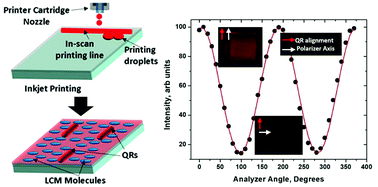Inkjet-printed aligned quantum rod enhancement films for their application in liquid crystal displays†
Abstract
Semiconductor quantum rods (QRs) show a polarized emission, which opens up the possibility of the enhancement of both brightness and color for liquid crystal displays (LCD) in the form of quantum rod enhancement films (QREFs) for LCD backlights. However, the QR alignment over a large area, suitable for displays, is a challenge. Inkjet printing of QREFs, introduced here, allows fabrication of well-aligned, uniform QREFs on photoaligned substrates using optimized QR inks. We observed that the ink composition and printing conditions affect the QR alignment quality significantly. A relative humidity of 50% with an exposure energy of 1 J cm−2 for the photoalignment process provided optimal conditions for QREFs. We have successfully shown a good QR alignment for 2.5-inch films and were able to align QRs in multiple layers. Thus, fabricated QREFs show a polarization ratio of 7.2 : 1 for the emitted light. These QREFs were combined with a blue LED and deployed as a backlight unit for an LCD which shows a brightness of ∼250 nits with an optical efficiency of ∼8%, reaching an NTSC of 109% in a CIE1976 color space. Thus, these printed QREFs, over a large area, provide an unprecedented increase of 77% in the optical efficiency of the LCDs and simultaneously offer better color performance.



 Please wait while we load your content...
Please wait while we load your content...